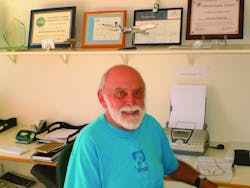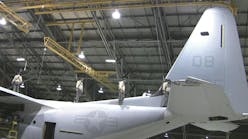Across the whole aviation spectrum there can be found a large number of organizations whose time and energy are devoted to improving and enhancing the vital element of safety within the industry. As to be expected, the majority of them have a pure focus on flight safety, for it is this issue which is constantly being raised by the world’s general news media, thus thrusting it into the public arena. Unfortunately, the news media pays very little attention to, and appears to have a sparse knowledge of, the other side of the aviation safety coin, namely the hazards associated with the activities performed on the ground at every airport.
That side of the coin can carry a variety of names; ground safety, ramp safety, airside safety, being typical examples. But regardless of its calling, the simple fact is that, as with all safety matters, unless it is managed properly, the outcome will be accidents and incidents which have a costly effect both in human and productivity terms.
Airside activities are conducted by people from a variety of companies including airlines, aircraft handlers, caterers, airport companies, maintenance organizations, fuel companies, cargo operators, couriers, law enforcement agencies and so on. Each of them has their own set of operating policies and procedures which must dove-tail into the overall requirements of the State (Federal or Local) regularity authority. But also, within reason, the operating procedures of all organizations need to be in tune with those of others with whom they are required to interact while carrying out their airside tasks. It is therefore very important that the line management and the staff of these operating companies work very closely together as a community to ensure safety standards and parameters are established, audited, and maintained. Overseeing these matters is where the respective company safety personnel have their part to play.
Having established good working relationships within each airport, the next step is to broaden the horizons within manageable geographic regions by making contact with people performing similar tasks at other airports. All it needs is for someone to take the initiative to communicate with his or her peers. The AAGSC started in just that way.
For some time, the ground safety officers of Trans Australia Airlines (TAA) and Air New Zealand had been discussing various aspects of their day-to-day work in the hope of finding and exchanging safer operating procedures. This was in the early 1980s when communication was best achieved by letter, telex, and the relatively new fax method. Eventually, a personal meeting was arranged and, while the two airlines had very little in common in respect to aircraft types operated, it was apparent that such cooperation was valuable and should be encouraged. As a result, it was decided to approach other airlines with a view to forming a group with whom to benchmark and create a working network.
A precedent for this had already been set up by the establishment of the Australasian Airline Flight Safety Council (AAFSC) and was, therefore, quite readily accepted and agreed upon by the management of the four airlines involved. In addition to TAA and Air NZ, Qantas Airways and Ansett-ANA had also been recruited and this led to the first meeting of ground safety personnel from all the carriers in March 1982 and the forming of the AAGSC.
One of the first things the Council had to address was the scope of its activities. Ground safety covers a plethora of wide-ranging subjects and it was agreed to limit the Council’s activities to those areas outside the hangars, thus placing its focus on the airport ramp and terminal operations.
From there, the next recruits were the Royal Australian Air Force and the Royal New Zealand Air Force. Both had already joined the AAFSC and their involvement with the AAGSC was simply a logical extension of that.
Due to the nature of the business and the identification of expanding issues, it soon became apparent that the Council needed to expand its membership base to include other organisations with ramp and terminal responsibilities. This led to the fuel companies, catering companies, ground handling agencies and the like being offered membership of the Council.
But In 1997, a really major change was made. It had become a practice to allow representatives from some of the major airports in the region to attend meetings as guests and it was the growing number of airport representatives attending meetings that led the Council to make a very small, yet very significant, change to its title. The word “Aviation” was substituted for “Airline”. The Council was now to be known as the Australasian Aviation Ground Safety Council.
This was a very positive move. The evolution to the aviation industry and legislation changes led to wider responsibilities and accountabilities being placed on the airport authorities, and the dependency of the various parties on each other to ensure all legal requirements were met was becoming extremely important.
Over the years the membership of the AAGSC has changed considerably. Both TAA and Ansett-ANA are no longer in existence but new airlines have emerged. The Council now boasts members operating aircraft such as the A380, the Dash 8 and ATR 72, and nearly all Boeing and Airbus models. No less than 17 Australian and New Zealand airports are represented, as are airport support management and consultancy companies. Altogether, membership now numbers over 50 and interest within the region is strong with six new members joining over the last 12 months.
It is truly amazing what can be achieved with comparatively little effort. For example, recognizing that the State authorities play a large part in setting operating rules and working parameters, the regional safety organisation has the opportunity to present a combined voice on the shaping of new rules and/or amendments to those already in existence thus providing greater weight to arguments for or against changes. The group also has the capability of setting its own recommended procedures in order to assist its members in meeting those rules.
Sometimes the cost of producing safety training and promotional material can be very expensive and this is where a regional group can pool financial resources for the benefit of all concerned. Recognising the need for wide appeal such material can consist of DVD or video training aids, task-specific posters, banners for display in major work areas and, probably most importantly, a dedicated website that is able to be accessed privately by group members and with more limited public access. By this means there is even the possibility of attracting sales of some products outside the region. (A considerable amount of information regarding the AAGSC can be found at their website, www.aagsc.org).
It is very important that these regional groups be set up on sound business principles, including a carefully worded charter or constitution overseen by an executive led by a suitably qualified chairperson. Other members of the executive should include the secretary, treasurer, and other officials as required to carry out the variety tasks that may be undertaken. A meeting schedule should be set to a regular timetable which should also provide for an Annual General Meeting to deal with administration matters.
Inevitably, members of the Executive team will from time to time need to be replaced; either through retirement, moving on to new positions internally or outside of their company, or through the regular rotation policy set out in the organisation’s charter or constitution. Invariably, the Executive provides the “glue” to keep the organisation on track so it is essential that senior members, such as past office holders keep a watchful eye on Executive succession planning.
Becoming involved in the activities of a regional safety organisation can be a most rewarding experience. It encourages benchmarking and networking between peers and provides the opportunity to meet others from different cultures and backgrounds. The extreme value of benchmarking and networking by parties operating similar ground support equipment and aircraft can never be over-stated. As with any organisation, its success depends entirely on the efforts made by its members and it is important to ensure that the work involved is spread across the entire membership.
Finally, a regional safety organisation can develop the strength to become recognised within the industry and the AAGSC is proud to have been involved in assisting in the establishment of a similar body within Europe, the European Aviation Group for Occupational Safety and Health, and also providing service to the IATA Airside Safety Group and the Flight Safety Foundation’s Ground Accident Prevention program.




